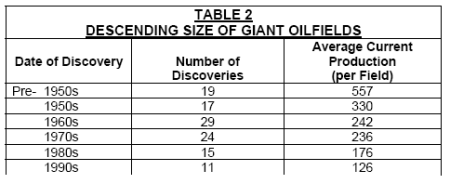Oil
- Identified conventional crude oil reserves are, as expected, dominated by the Middle East.
- Much of this is based on the word of the host countries, and is subject to political manipulation. There is no solid data.
- Very few reserves remain in the key consumers (4% in the US, 1% in Europe).
- The Top 5 producers of crude oil in 2007, including NGL, were:
- Russia (487Mt, 12.4%),
- Saudi Arabia (483Mt, 12.3%),
- US (310Mt, 7.9%),
- Iran (218Mt, 5.5%),
- and China (188 Mt, 4.8%).
- Of the Top 5 producers of 2007 the US and China consumed more than they produced, also making the list of the top 5 importers (Japan, Korea, and India made the rest of the consuming top 5).
- The US imported 587Mt in 2007.
- The top 5 exporters in 2007 were:
- Saudi Arabia (358Mt),
- Russia (248Mt),
- Iran (130Mt),
- Nigeria (119Mt),
- Norway (109Mt).
Gas
- Gas production grew from 1,227bcm in 1973 to 3,031 bcm in 2007.
- OECD control of this resource has dropped from 71.3% in 1973 to 37.4% in 2007.
- The big growth gas areas have been pretty much everywhere outside of the OECD:
- USSR (19.7% – 27.7%),
- Africa (0.8% – 6.8%),
- Latin America (2% – 4.8%),
- Asia (1% – 9.3%)
- Middle East (2.1%-11.3%).
The Importance of Big Fields
- As of the year 2000, over 4,000 named oilfields with a population of almost one million individual wells created a 68 million bopd supply (out of a total 76 million bopd daily demand inclusive of NGL)
- The average field produced less than 20,000 barrels per day.
- World crude oil production is well described by a parabolic fractal distribution, with small fields creating relatively minor production add, and just a few fields (<100) contributing more than 50%. That’s a long tail…
- The top 100 of the world’s oilfields ranked by production, just 3% of the total, contain 65% of estimated proved reserves and accounted for 51.6% of the world’s production in 2006.
- The top 20 of the world’s oilfields by production contained 40% of estimated proved reserves and accounted for 27.7% of the world’s production in 2006.
- Just 10 oilfields account for 29.9% of the worlds estimated proven reserves and accounted for 20.4% of the world’s production in 2006.
- The four largest oilfields account for 12% of the world’s supply, more than the aggregate of all of the oil produced in every other continent outside the Middle East.
- Even in North America, which has over 600,000 individual oil wells, 17 giant fields account for 32% of North America’s daily supply.
- The average age of the 14 largest fields is 43.5 years (Simmons and Co), these fields still produce > 500,000 barrels a day.
- The average age of the 19 largest oil fields is almost 70 years (Simmons and Co).
- The age distribution of the world’s giant oilfields also indicates that older fields still produce far higher volumes of oil than the newer giant oilfields.
- Thirty years ago, the world’s top ten oilfields produced over 10 mbopd (of 50mopd world total). Their average production was just over 1 million barrels a day each.
- In 2001 the world’s top ten oilfields produced much more than this.
- However, many of these fields are old and no longer have any production growth capacity – many are actually in decline (for example, Cantarell, the last supergiant field with a production potential > 1 million barrels a day was discovered in 1976).
- Only a handfull of new oil fields that initiated production in 2006-2009 are estimated to produce > 100,000 bopd.









